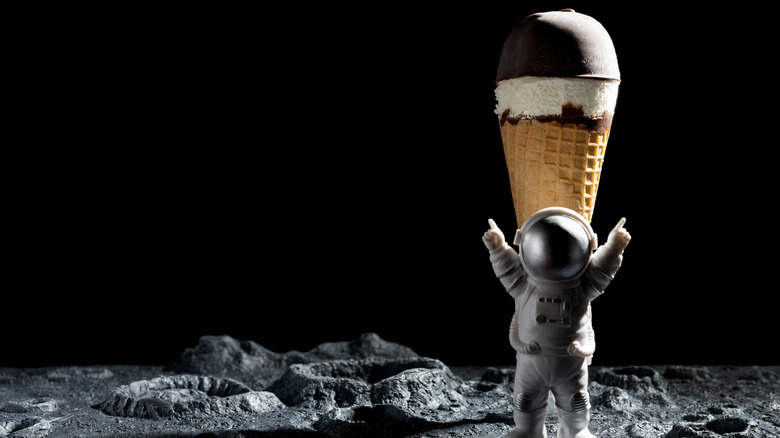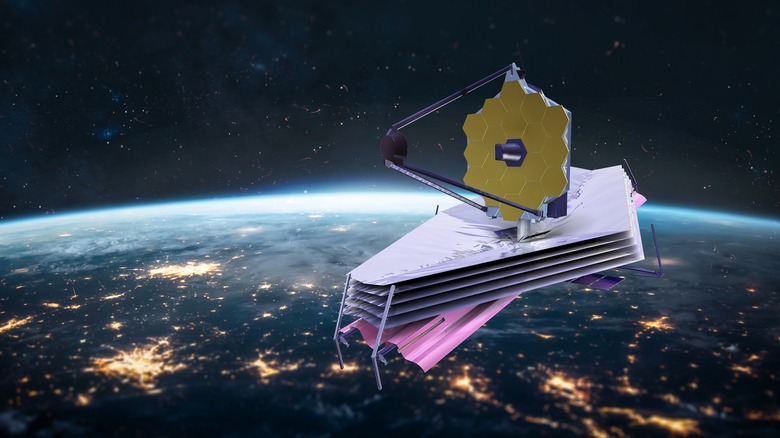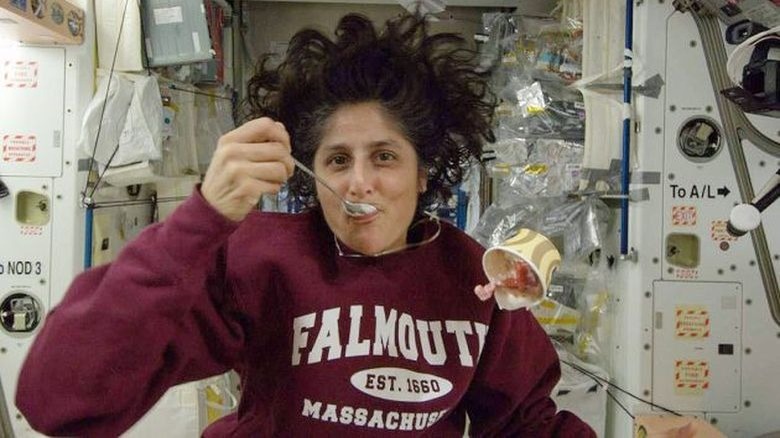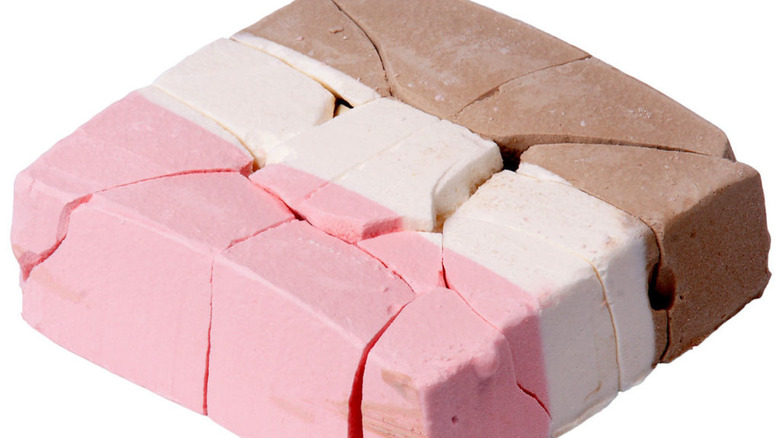

The Reason Why Astronauts Can't Have Astronaut Ice Cream In Space
source link: https://www.slashgear.com/937441/the-reason-why-astronauts-cant-have-astronaut-ice-cream-in-space/
Go to the source link to view the article. You can view the picture content, updated content and better typesetting reading experience. If the link is broken, please click the button below to view the snapshot at that time.
The Reason Why Astronauts Can't Have Astronaut Ice Cream In Space

"I scream, you scream, we all scream for ice cream," especially if you're an astronaut. We all know that in space, no one can hear you scream, but even if you did, no astronaut ice cream would be given to you on the final frontier.
In 1968, Walter M. Schirra, Donn F. Eisele, and R. Walter Cunningham climbed aboard Apollo 7 and became the first astronauts to crew a mission in NASA's famed Apollo program. It was also the first time freeze-dried Neapolitan ice cream was eaten (out of pouches) in space. It was also the last.
That's not to say ice cream never made it back into space. In 2006 the Space Shuttle Atlantis made a supply run to the International Space Station (ISS). Part of its payload included a new freezer — affectionally called GLACIER — so astronauts could store research samples.
Instead of just sending up an empty freezer, NASA packed it with Blue Bell ice cream cups (vanilla with swirls of chocolate sauce). Six years later, in 2012, more Blue Bell ice cream (chocolate, vanilla, and birthday cake flavors) made it to the ISS aboard a SpaceX Dragon resupply capsule. That was the last time the frozen creamy goodness officially went into space (via National Air and Space Museum).
Astronauts have rarely enjoyed ice cream in space
So if astronauts don't actually eat astronaut ice cream, why is it called "astronaut ice cream?" Good question.
As one might imagine, there were many problems to overcome during the early days of NASA, and one of those was figuring out a way to feed its astronauts. Weight is always a concern on space flights, and the tight quarters do not allow for much extra luggage space. Food needed to be light, have a long shelf life, and easily be packaged small while not letting crumbs fly willy-nilly around the environment. Lastly, while having Michelin-star quality wasn't a priority, it had to be easy to prepare and edible.
Freeze-dried food, which offers better nutrition than dehydrated food, has been a staple of NASA's menu from the very start. In fact, the space agency has contributed to the advancement of several different food preservation techniques (dehydration, freeze-drying, intermediate moisture, pasteurization by irradiation, and nitrogen packing) for decades (via NASA).
When the public's fascination with space flight took off in the late 1960s and early 1970s, museums worldwide wanted to cash in on the interest and began providing an assortment of space-related souvenirs to sell in their gift shops. The visitor center at the Ames Research Center in California came up with one that still lives in infamy.
Astronaut ice cream is... a gift shop gimmick
In 1973 Ames reached out to American Outdoor Products in Boulder, Colorado. At the time, it was one of the few companies manufacturing and selling freeze-dried food to the public. Ames wanted to know if American Outdoor could make the freeze-dried ice cream in bulk so they could sell it at their gift shop (via NASA).
Owner Ron Smith jumped at the chance but says the first versions of the now famous treat definitely weren't what everyone has come to know and love. They took frozen solid half-gallon containers of Neapolitan ice cream, cut them with a bandsaw, then freeze-dried it "using a specialized machine, which turned the ice directly into gas" (via Serious Eats). This sublimation process is how tiny air pockets replaced the ice crystals in the ice cream. About three-quarters of that sublimated, freeze-dried ice cream then got stuffed into a pouch.
They finally perfected the process for Ames, but Smith remained convinced it was only a fad. He was wrong. According to The Franklin Institute, "Astronaut Ice Cream" remains one of the most popular souvenirs around the world, selling more than 30,000 packages every year in its Sci Store.
And while it's a big hit on planet Earth, astronauts can't eat the brittle product in space because it's prone to break apart and get crumbs in all the wrong places. Precisely the same reason bread isn't allowed in space.
The James Webb Space Telescope: 10 Observational Targets

NASA predicts that in July of 2022 the James Webb Space Telescope (JWST) will take in its first view of the universe and send proper images back to astronomers on Earth.
The most powerful space telescope ever placed into orbit will see further into the cosmos — and thus further back in time — than any technology before it, thus allowing astronomers to glimpse conditions that existed shortly after the Big Bang.
The space telescope which is named after James Webb, the head of NASA from 1961 to 1968, will also make important observations closer to home.
In our galaxy, the Milky Way, the telescope will examine worlds beyond the solar system — extra-solar planets or exoplanets — scouring their atmospheres looking for the tell-tale signs of life like organic molecules and water.
And with the limits of our sun's influence in our solar system, the JWST will attempt to categorize hard-to-see asteroids, including some that could potentially be hazardous to our planet to discover how our planetary system forms.
Thus, the telescope will grant a deeper insight into space surrounding our planet and at much greater distances.
The early universe in infrared
Because light takes a finite time to travel through space, when astronomers view objects they are actually looking back in time. The light from the sun takes around seven minutes to reach Earth, meaning when we look at the sun, we are seeing it as it was seven minutes ago.
We are actually seeing distant objects as they existed centuries or millennia ago, and for the most distant objects and galaxies, we are observing them before Earth even formed, and by the time we spot them they may be unalterably changed or even destroyed.
The JWST is so powerful that it will be able to observe the universe as it existed around 13.6 billion years ago, which is just 200 million years after the period of initial rapid inflation that we call the Big Bang. This is the furthest back in time humanity has ever looked, beating the view provided by the Hubble Space Telescope by around 600 million years.
What makes the JWST such an effective tool to visualize the early universe is that it conducts its observations in the infrared region of the electromagnetic spectrum.
As light travels to us from these distant sources the accelerating expansion of the Universe stretches that light. This means that even though the light that leaves those early stars and galaxies is similar to the light from closer stars and galaxies closer to home, its wavelength is "redshifted" towards the infrared end of the electromagnetic spectrum.
The most distant and earliest galaxies
One of the ways that the JWST will pinpoint early galaxies is by observing six of the most distant and luminous quasars.
Quasars sit at the center of active galactic nuclei (AGN) and are powered by feeding supermassive black holes. They are often brighter than the emissions of every star in the galaxy that houses them put together.
The quasars selected by the JWST team are some of the brightest, meaning the black holes that power them are both the most massive and are consuming — or more accurately accreting — gas and dust at the highest rates. They are generating huge amounts of energy that is heating surrounding gas and pushing it outward, creating powerful outflows that rip through galaxies into interstellar space.
As well as using quasars that are having a pronounced effect on their surrounding galaxies to understand their evolution, the JWST researchers will also use quasars to investigate a period of the Universe's history called the Era of Reionization. Occurring over 13 billion years ago, this was the point at which the Universe became more opaque and allowed light to travel freely. This happened because neutral gas in the intergalactic medium became charged or ionized.
The JWST will investigate this by using bright quasars as background light sources to study the gas between us and the quasar. By seeing what light is absorbed by interstellar gas, researchers can determine if the intervening gas is neutral or if it has been ionized.
100 Galaxies at Once
One of the tools that the JWST will use to observe the universe is the Near-Infrared Spectrograph (NIRSpec). This instrument won't make visually stunning images of the galaxies it observes like the wide-field image of thousands of galaxies taken by the Hubble Space Telescope seen above. Instead, it will provide vital spectrographic information about these galaxies — glimpsing many at once.
The spectra of these galaxies contain a wealth of information, in particular, chemical compositions. By studying these compositions researchers can see how quickly galaxies can convert their gas content into stars and thus better understand the evolution of the universe.
Doing this with precision requires blocking out a great deal of light and normally means studying one object at a time. Some of the objects the JWST intends to study are so distant that their light is incredibly dim, which means they must be observed for hundreds of hours to collect sufficient data to build a spectral pattern.
Fortunately, the NIRSpec is equipped with a quarter of a million individual windows with human hair-sized micro-shutters arranged in a waffle-shaped grid. This means that by adjusting the pattern of these shutters the JWST will be able to observe many objects in one viewing for simultaneous observation and it is programmable for any field of objects in the sky.
NASA estimates that this will allow NIRSpec to collect spectra from as many as 100 observational targets at once, something no other spectroscope has ever been able to do before.
Jupiter-sized exoplanets
Since the mid-1990s and the discovery of a planet orbiting a sun-like star, our exoplanet catalog has burgeoned and now contains over 4,000 confirmed worlds. Most of these worlds — including exoplanet 51 Pegasi b, found by the Swiss team of Michel Mayor and Didier Queloz in 1995 — are hot Jupiters.
These exoplanets orbit their stars in close proximity, usually completing an orbit in a matter of hours, making them easy to spot using exoplanet observation methods.
These worlds are often tidally locked to their star, meaning one side, the perpetual dayside, is blistering hot. A startling example of such a world is WASP-121b, recently observed by a spectroscopic camera aboard Hubble. Just a touch larger than Jupiter in our own solar system, iron and aluminum are vaporized on the dayside of this planet, and this vapor is blown to the nightside by supersonic winds.
When these elements cool they fall as metal rain, with the possibility that some of the aluminum may bind with other elements and fall as liquid ruby and sapphire rains.
The proximity of these giant planets to their parent star can result in them being pressed into a football shape by tidal forces. This was observed with the exoplanet WASP-103b, which is almost twice the size of Jupiter and orbits its star in under an Earth-day.
Part of the role of the JWST from its position one million miles from Earth will be to examine the environments and atmospheres of these violent planets.
Super-Earths
Some of the worlds outside the solar system that the JWST will be studying may seem more like Earth in many ways but are no less remarkable than hot Jupiters. Another category of exoplanet that the space telescope will be used to observe is so-called super-Earths. These are worlds that can be up to 10 times more massive than Earth but are still lighter than ice giants like Neptune or Uranus.
Another class of planet that is absent from the solar system, super-Earths don't have to be rocky like our planet, but can be composed of gas, or even a mixture of gas and rock. NASA says that in the range of 3–10 times the mass of Earth, there might be a wide variety of planetary compositions, including water worlds, snowball planets, or planets that, like Neptune, are composed largely of dense gas.
The first two super-Earths to fall under the gaze of the JWST will be the lava-covered 55 Cancri e, which is a seemingly rocky world located 41 light-years away, and LHS 3844b which is twice the size of Earth and seems to have a rocky surface similar to the moon but lacks a substantial atmosphere.
Both of these worlds seem to be pretty inhospitable to life as we know it, but other exoplanets that will be studied using the JWST could be more promising prospects for the existence of life elsewhere in the Milky Way.
The TRAPPIST-1 system
During the first operating cycle of the JWST, the telescope will look closely at the TRAPPIST-1 system, located 41 light-years from Earth. What makes this planetary system, discovered in 2017, extraordinary is the fact that its seven rocky worlds exist in the habitable zone of their star, making it the largest cluster of potentially habitable Earth-like worlds ever discovered.
Astronomers define the habitable zone around a star as the region where temperatures allow for the existence of liquid water. Because the area is neither too hot nor too cold for water to exist in a liquid state, it is often called the Goldilocks zone.
Existing in this zone doesn't immediately mean that a planet is suitable for habitation, however. Both Venus and Mars are inside the habitable zone around the sun and neither of those planets could comfortably host life as we understand it because of other conditions. Mars, for example, has lost its atmosphere and magnetosphere that could have once protected complex organic molecules from harsh and destructive solar radiation.
The Planetary Society suggests that other factors such as the strength of solar winds, the density of a planet, the prevalence of large moons, the orientation of the planet's orbit, and the planet's rotation (or apparent lack thereof) could all be key factors for habitability.
The JWST will characterize the atmospheres of the TRAPPIST-1 planets and attempt to discover if they would make suitable environments where life could prosper. Various research teams using the JWST will also attempt to discover organic molecules in the atmospheres of these planets as well as water, looking for a hint that life could already exist there.
Organic molecules and planetary birth
One of the advantages that the JWST's infrared view of the Universe will deliver is the ability to stare into dense and massive clouds of interstellar gas and dust. While this may not seem immediately exciting, the prospect becomes much more enticing when considering these are the sites in which stars and planets are birthed — referred to as stellar nurseries.
These regions of space can't be observed in the visible light spectrum as their dust content makes them opaque. This dust does however allow electromagnetic radiation in infrared wavelengths to travel. This means that the JWST will be able to study dense regions of these gas and dust clouds as they collapse and stars form.
In addition to this, the space telescope will also be able to investigate the discs of dust and gas that surround infant stars and give rise to planets. This could not only reveal how planets like those in the solar system — including Earth — form, but it could also reveal how organic molecules vital for life are dispersed within these so-called proto-planetary discs.
And there is one stellar nursery that researchers with observation time on the JWST will be honing in on in particular.
The Pillars of Creation
The Pillars of Creation represent one of the most striking and beautiful cosmic sights ever captured by mankind. But, despite its inarguably impressive observational power, the Hubble Space Telescope — which has produced beautiful images of the Pillars of Creation like the ones above — can only see so deep into these towers of gas and dust that stand several light-years tall.
Located in the Eagle Nebula and 6,500 light-years from Earth in the constellation Serpens, the opaque columns that make up the Pillars of Creation are the sites of intense star creation. To gather details of the star-birthing processes within the pillars, Hubble has been viewing them in optical and infrared light.
Infrared light is needed to view the processes occurring within the Pillars of Creation because — just as with other stellar nurseries — visible light cannot penetrate the dense dust of this emission nebula.
Hubble is optimized for visible light and yet has still been able to capture stunning infrared images of the pillars showing some of the young stars dwelling within it. This is something that has the JWST team excited about what their powerful infrared space telescope will reveal about this fascinating region of space.
Jupiter, Its Rings and Moons
While much of the science conducted by the JWST will concern distant objects, it will have work to do closer to home. The solar system still holds plenty of mysteries that need to be cracked.
One of the space telescope's solar system-based targets will be its largest planet, the gas giant Jupiter. According to NASA, a team of over 40 researchers has developed an observing program that will study Jupiter, its ring system, and two of its moons: Ganymede and Io.
This will be one of the telescope's first investigations within the solar system and will require it to be calibrated for the brightness of the gas giant while at the same time being able to observe its much dimmer ring system.
The JWST team that will be observing Jupiter will also have to take into account the planet's 10-hour day. This will require "stitching together" separate images to study one specific area of the rapidly rotating fifth planet from the sun such as the Great Red Spot — the largest storm in the solar system which is deep and wide enough to swallow the entire Earth.
What astronomers will be looking to better understand is the reason for variations in atmospheric temperature above the Great Red Spot, the characteristics of Jupiter's extremely faint rings, and if the Jovian moon Ganymede possesses a liquid saltwater ocean beneath its surface.
Not all of the JWST's solar system targets will be as prominent as Jupiter, however.
Asteroids and Near-Earth Objects
One of the other major roles the JWST will have in the solar system is studying asteroids and other smaller solar system bodies in infrared.
This will include what NASA classifies as Near-Earth Objects (NEOs), which are comets and asteroids that have been nudged by the gravitational attraction of nearby planets into orbits that allow them to enter the Earth's neighborhood.
The JWST will make infrared observations of asteroids and NEOs that aren't possible from within Earth's atmosphere by ground-based telescopes or by less powerful space-based telescopes.
The aim of these asteroid assessments will be to study the absorption and emission of light from the surface of these bodies which should help better understand their composition. The JWST will also allow astronomers to better categorize the shapes of asteroids, their dust content, and how they release gas.
The JWST will be looking to compare these objects to asteroids still located in the Main Asteroid Belt located between Mars and Jupiter, particularly their orbits and rotational speeds.
The study of asteroids is vital to scientists who aim to understand the birth of the solar system and its planets 4.5 billion years ago. This is because they are comprised of "unspoiled" materials that existed as the planets were forming which escaped the pull of planets forming smaller bodies.
Along with studying the birth of planets, stars, and the earliest moments of galaxies themselves, this mission again exemplifies how the JWST will address some of science's most fundamental mysteries.
Recommend
About Joyk
Aggregate valuable and interesting links.
Joyk means Joy of geeK

